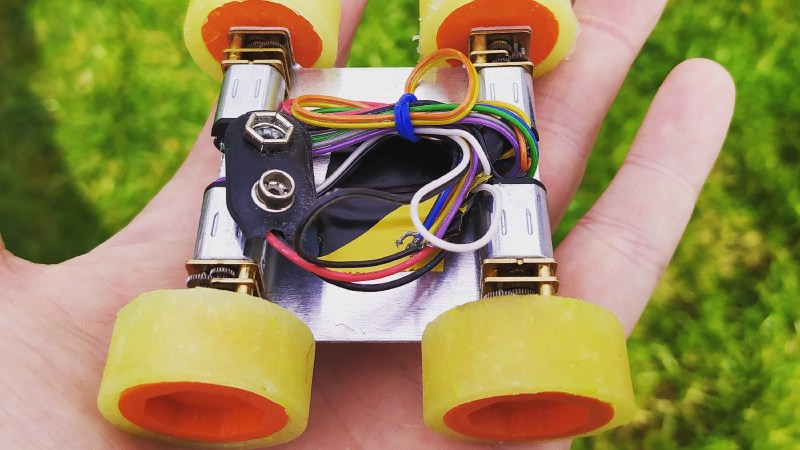For people who work with wheeled robots or RC vehicles, sooner or later one gets interested in making custom tires instead of dealing with whatever is available off the shelf. [concreted0g]’s preferred method is to design and 3D print wheel hubs, then cast some custom silicone tires to fit over them. Of course, the devil is in the details and this process can be a bit messy, so he’s shared useful tips on how to get reliable results with simple materials.
 The casting material is cheap silicone caulking from a hardware store, and color can be added with a small amount of cheap acrylic paint. A few drops of glycerin added to the silicone thins it out slightly and helps it flow into a mold better. Mix well (the paint will also serve as a visual indicator of how well it is mixed), then scoop the mixture into the mold while trying to avoid creating air pockets. If your mold is in two pieces, assemble the mold and remove any overflow, then let it sit undisturbed for at least several hours while it cures.
The casting material is cheap silicone caulking from a hardware store, and color can be added with a small amount of cheap acrylic paint. A few drops of glycerin added to the silicone thins it out slightly and helps it flow into a mold better. Mix well (the paint will also serve as a visual indicator of how well it is mixed), then scoop the mixture into the mold while trying to avoid creating air pockets. If your mold is in two pieces, assemble the mold and remove any overflow, then let it sit undisturbed for at least several hours while it cures.
Mounting the resulting tire to a wheel hub can be done with a thin film of super glue, which seems to work perfectly well for small tires and is easy to apply.
The rules are going to be a bit different for big objects. We know that silicone caulking can have difficulty fully curing when it’s applied thickly, especially when sealed into a mold with little to no airflow. In such cases, adding cornstarch (in about a 5:1 ratio of silicone to cornstarch by volume) is all that it takes to cure even thick wads of goop in less than an hour. Stirring cornstarch in tends to introduce more air bubbles into the mixture, but for larger pieces that can be an acceptable tradeoff. Cheap silicone caulking is versatile stuff, one just needs to know what to expect, and take a few steps to deal with the messiness.
Need something tougher? Maybe check out using slices of automotive silicone hose for robot wheels to get something that works just as well, but is a lot more durable.















I see something the kids will enjoy doing at the local Best Robotics team!
Would probably try acetone to thin it as it’ll eventually evaporate back out. Also, have lots of acetone…
No. Either use glycerine and water, or you have to use xylene, turpentine etc. Do more than a superficial search and you’ll see.
I have some silicone conformal coating that I really like, works great. Also absurdly expensive. I thought about trying to thin some silicone caulk/glue and make my own. I did a ton of research on what to thin it with. NO consistent answers. Acetone, Xylene, Glycol/Glycerine, Mineral Spirits, Mineral Oil, Turpentine, EMK, and Benzene are just some of the different solvents I found listed to supposedly thin Silicone. I thought of running my own experiments, but didn’t want to go out and buy 10+ different chemicals.
i think id just print custom hubs and dip into my seemingly unlimited supply of lego tires. they are the biggest tire manufacturer on the planet by units produced after all.
why use caulk at all? Its not like proper tin or platinum cure silicone is that much more expensive.
Urethane would be a better choice for wheels anyway
Some cheeses would probably work better too. But mice.
Urethane wouldn’t give you the grippy, squishy consistency that silicone would, right? They’d perform more like skate wheels.
Polyurethane can be whatever you want it to be. It’s fantastically versatile. Rubbery? Yep. Brittle? Yep. Anywhere in between? Yep. Transparent? Yep. Opaque? Yep. Solid? Yep. Foamy? Yep.
And the best thing is you can mix it to get what you want. Buy a hard one and a soft one and now you can produce any hardness you want by mixing a bit of this and a bit of that. It’s great.
I’ve mixed different versions of the part b for Smooth-On Crystal Clear (but not the one that requires post-curing) to alter its curing time. Haven’t done that in a while, I think they’ve slowed down 202 some. I have some castings that I wasn’t able to get the mold filled and in a pressure tank before it’d begin to set but not long after I mentioned to the company I was mixing 202 50:50 with 200 to slow it down enough to get the big but thin item filled.
Interesting. As someone just learning about this for the first time, I see clear/smooth polyurethane resin kits and foam polyurethane kits; you can mix the foaming and non foaming ones? Or are there clear but squishier ones? Any particular brands or maybe links which talk about this?
Vacuum chambers work wonders in pulling out the air bubbles. and a bit higher temperatures .